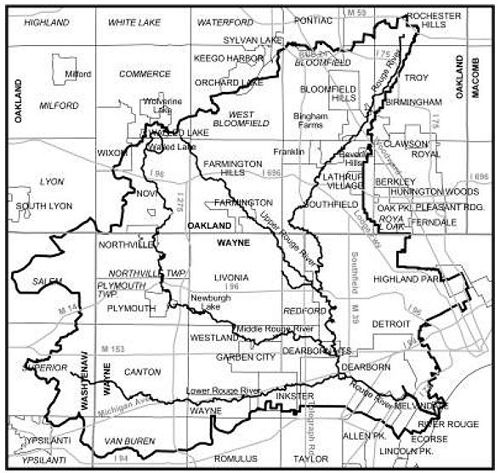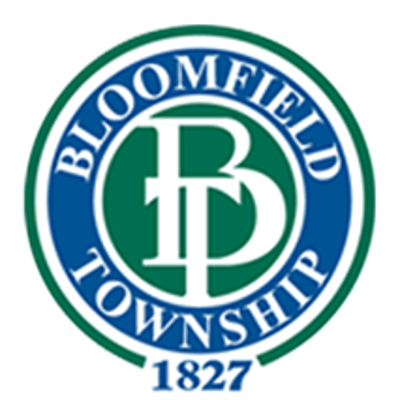A watershed is made up of the land area that drains to a specific body of water, such as a tributary, stream or river. The topography of our local hills and valleys define the watershed boundary (catchment area) and the watershed outlet is the mouth of a pond, river or lake.
Rouge River Watershed
|
Quick Link
Watershed Wisdom for Homeowners |
Bloomfield Township makes up the headwaters of the Rouge River Watershed. The Rouge River is 126miles long and is comprised of four major subwatershed branches: the Main, Upper, Middle, and Lower meandering through 48 communities. The watershed is approximately 438 square miles.
Bloomfield Township, along with 17 other communities and the Office of the Oakland County Drain Commission, is an active participant in the Main 1-2 Subwatershed of the Rouge River. Bloomfield Township contributes to the Main 1-2 branches of the Rouge River. The Main 1 and 2 Subwatershed Advisory Group (SWAG) consists of representatives from each of these communities, which has developed a watershed management plan for this region. Effective watershed planning includes public involvement as well as public education to better manage our waterways.
Map - Bloomfield Township Watershed

Alliance of Rouge Communities (ARC)
 In January 2005, the Governor signed into law Public Act No. 517 of 2004, which allows for the establishment of watershed alliances for the purpose of studying, planning, and implementing activities to address surface water quality. The Township, along with several communities and counties in the Rouge River Watershed, has adopted the Bylaws for the creation to establish the Alliance of Rouge Communities (ARC). The ARC is an organization made up of public entities to cooperatively manage mandatory programs such as public education, water quality monitoring and facilitation of the watershed management plans that are required with all members' Municipal Separate Storm Sewer System (MS4) permit coverage.
In January 2005, the Governor signed into law Public Act No. 517 of 2004, which allows for the establishment of watershed alliances for the purpose of studying, planning, and implementing activities to address surface water quality. The Township, along with several communities and counties in the Rouge River Watershed, has adopted the Bylaws for the creation to establish the Alliance of Rouge Communities (ARC). The ARC is an organization made up of public entities to cooperatively manage mandatory programs such as public education, water quality monitoring and facilitation of the watershed management plans that are required with all members' Municipal Separate Storm Sewer System (MS4) permit coverage.
At this time, there is federal grant funding (Wayne County is the grantee) available to be used in part to formally establish this Alliance through the year 2006. Although the Alliance is voluntary, the Federal Court as well as the MDEQ endorses such a venture to maintain compliance with the federal storm water regulations and allow the opportunity to have local control on management strategies in the watershed. One potential benefit of the Alliance will be the efforts to establish one watershed permit in lieu of multiple permits in the watershed, as well as, providing a means for future grant funding.
Clinton River Watershed
Less than half a square mile of the Township lies within the Clinton-Main Subwatershed of the Clinton River Watershed. Although Bloomfield Township only makes up a small portion, the entire watershed covers approximately 760 square miles in 4 Southeast Michigan counties - about 40% of eastern Oakland County, most of Macomb County, and small portions of southern Lapeer and St. Clair counties.
The Clinton River and its tributaries flow through 60 rural, suburban, and urban communities with a total population of more than 1.6 million. Beautiful inland lakes can be found in the western portion of the watershed, and the river basin is home to a variety of wetland and other ecosystem types, from open marshes rich with waterfowl to hardwood forests sheltering rare wildflowers.
Map - Clinton Township Watershed

FAQ
 1. Why should I be concerned with watershed management?
1. Why should I be concerned with watershed management?
Everyone has the potential to pollute the water or help restore its health. Less than 2% of today’s water pollution is caused by industry. Storm water runoff can pick up bacteria, heavy metals, nutrients, oil, grease, pesticides, and soil particles. The actions of residential landowners have a direct effect on our area lakes, ponds, rivers, and wetlands.
2. What does watershed management accomplish?
- Provides an organized framework to asses the status of the watershed #9; ecosystem
- Creates a forum to determine goals and objectives
- Inform local residents regarding pollution hazards and preventative measures
3. What are the consequences of water pollution?
- Alters the sediments and nutrients of the water which effect aquatic life
- Aesthetics are degraded by cloudiness, solid wastes, and oil, which can lead to loss of recreational uses
If you observe any suspicious discharge into a storm drain or waterway, please contact the Department of Public Works 24-hour emergency line at 248-433-7730 or contact the Oakland County Drain Commissioners hotline at 248-858-0931 or report an environmental concern online.
